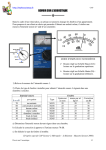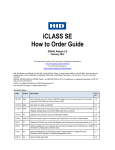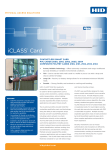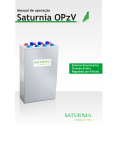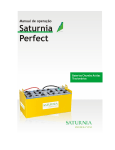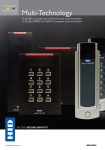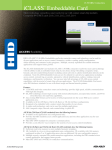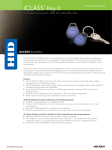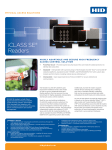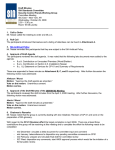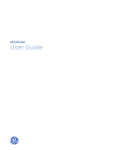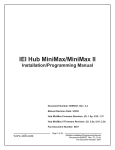Download HID Mobile Access Reader Deployment Guide
Transcript
HID Mobile Access Reader Deployment Guide For Site Administrators and Integrators PLT-02076, Rev. A.0 October 2014 hidglobal.com HID Mobile Access Reader Deployment Guide, PLT-02076, Rev. A.0 Contents Contents ........................................................................................................................................ 2 Copyright ....................................................................................................................................................................... 4 Trademarks ................................................................................................................................................................... 4 Revision History .......................................................................................................................................................... 4 Contacts ......................................................................................................................................................................... 4 1 Purpose ................................................................................................................................... 5 2 References ............................................................................................................................. 5 3 Background ........................................................................................................................... 5 3.1 HID iCLASS SE Mobile Access Readers ....................................................................................................5 3.2 Seos 5 3.3 Bluetooth LE (BLE) ........................................................................................................................................... 6 3.3.1 3.3.2 3.3.3 Pairing .............................................................................................................................................................................6 Power...............................................................................................................................................................................6 Advertising Data .........................................................................................................................................................6 3.4 Near Field Communication ............................................................................................................................ 6 3.4.1 3.4.2 Storing Mobile ID in Android OS using Host Card Emulation .................................................................6 Storing Mobile ID in the Secure Element (SIM or handset provider) ................................................... 7 3.5 Types of Mobile Access Readers ................................................................................................................. 7 3.5.1 3.5.2 3.5.3 Mobile-Enabled............................................................................................................................................................ 7 Mobile-Ready ............................................................................................................................................................... 7 Mobile-Capable ........................................................................................................................................................... 7 4 Terminology........................................................................................................................... 7 5 Operational Overview ......................................................................................................... 8 5.1 5.2 5.3 5.4 5.5 5.6 6 BLE Benefits and Modes of Operation ......................................................................................................8 Similarities between BLE and Contactless Proximity Credentials.................................................8 Differences between BLE and Contactless Proximity Credentials............................................... 9 Mobile and Cards ............................................................................................................................................... 9 Detecting and Authenticating BLE Devices .......................................................................................... 10 Comparison of Mobile Technologies BLE and NFC ........................................................................... 10 Infrastructure Needs and Solution Capabilities ........................................................... 11 6.1 Reader Infrastructure ....................................................................................................................................... 11 6.1.1 6.1.2 6.1.3 Site Survey ................................................................................................................................................................... 11 Determining by Mobile Device ............................................................................................................................ 11 Determine By Applications ................................................................................................................................... 11 6.2 Unusual Use Cases ............................................................................................................................................ 11 6.2.1 6.2.2 6.2.3 6.2.4 7 125 kHz Indala Credential Support ..................................................................................................................... 11 First Version iCLASS SE (Rev D) ....................................................................................................................... 12 Mobile-Ready Readers ........................................................................................................................................... 12 Mobile-Capable Readers ....................................................................................................................................... 12 Installer Deployment Preparation ................................................................................... 13 7.1 Equipment List for Mobile-Enabled Readers ........................................................................................ 13 7.2 Additional Equipment when Converting Mobile-Ready Readers ................................................ 13 7.2.1 8 Personalization Configuration Card ................................................................................................................. 13 Environmental Considerations......................................................................................... 14 8.1 Reader Form Factor ........................................................................................................................................ 14 8.2 Reader Mounting Surface and Other Environmental Conditions................................................. 14 8.3 BLE Reader Metallic Insert with Adhesive (for Back Plate or Spacer) ...................................... 14 October 2014 Page 2 of 26 HID Mobile Access Reader, Deployment Guide, PLT-02076, Rev. A.0 8.4 Mobile Device Make and Model .................................................................................................................. 14 9 Installation Best Practices ................................................................................................ 15 9.1 9.2 9.3 9.4 9.5 Installation Workflow ...................................................................................................................................... 15 BLE Configuration Tips .................................................................................................................................. 16 NFC (HCE) Configuration Tip ...................................................................................................................... 16 Visible Identification for Users and Installers ....................................................................................... 16 Troubleshooting ................................................................................................................................................ 17 Appendix: A Reader Identification .................................................................................... 18 A.1 25+ Years of Physical Access Readers .................................................................................................... 18 A.2 Finding Relevant Information on iCLASS SE Readers ...................................................................... 18 A.2.1 Mobile-Capable Reader ......................................................................................................................................... 18 A.2.2 Mobile-Enabled and Mobile-Ready Readers................................................................................................. 18 Appendix: B Reader Ordering Instructions .................................................................... 19 B.1 Overview .............................................................................................................................................................. 19 B.1.1 Purchasing Mobile-Ready versus Mobile-Enabled ..................................................................................... 19 B.2 Mobile-Ready Reader Part Numbers ........................................................................................................ 19 B.2.1 B.2.2 B.2.3 B.2.4 BLE BLE BLE BLE and/or NFC, No Prox (125 kHz), Non-Keypad, Wiegand .............................................................. 20 and/or NFC, No Prox (125 kHz), With Keypad, Wiegand ............................................................. 20 and/or NFC, with Prox (125 kHz HID Prox), Non-Keypad, Wiegand ........................................ 21 and/or NFC, with Prox (125 kHz HID Prox), with Keypad, Wiegand ........................................ 21 B.3 Reader Accessories ........................................................................................................................................ 22 B.4 Configuration Summary ................................................................................................................................ 22 B.4.1 B.4.2 B.4.3 B.4.4 B.4.5 B.4.6 B.4.7 B.4.8 B.4.9 Page 3 of 26 Form factor ................................................................................................................................................................ 22 Access Control Panel Interface ......................................................................................................................... 22 Access Control Panel Wiring Connection ..................................................................................................... 23 Color.............................................................................................................................................................................. 23 Audio/Visual Indication ........................................................................................................................................ 24 Keypad ......................................................................................................................................................................... 24 Card Compatibility .................................................................................................................................................. 24 BLE Configuration ................................................................................................................................................... 25 More Options ............................................................................................................................................................. 25 October 2014 HID Mobile Access Reader Deployment Guide, PLT-02076, Rev. A.0 Copyright ©2014 HID Global Corporation/ASSA ABLOY AB. All rights reserved. This document may not be reproduced, disseminated or republished in any form without the prior written permission of HID Global Corporation. Trademarks HID GLOBAL, HID, the HID logo, HID Mobile Access, iCLASS SE, multiCLASS SE, and Seos are the trademarks or registered trademarks of HID Global Corporation, or its licensors, in the U.S. and other countries. Revision History Date Description Version 10/1/14 Initial release A.0 Contacts For additional offices around the world, see www.hidglobal.com/contact. North America Asia Pacific 611 Center Ridge Drive Austin, TX 78753 USA Phone: 866-607-7339 Fax: 949 732 2120 19/F 625 King’s Road North Point, Island East Hong Kong Phone: 852 3160 9833 Fax: 852 3160 4809 Europe, Middle East and Africa Brazil Haverhill Business Park Phoenix Road Haverhill, Suffolk CB9 7AE England Phone: 44 (0) 1440 711 822 Fax: 44 (0) 1440 714 840 Condomínio Business Center Av. Ermano Marchetti, 1435 Galpão A2 CEP 05038001 Lapa - São Paulo/SP Brazil Phone: 55 11 5514-7100 HID Global Technical Support: support.hidglobal.com October 2014 Page 4 of 26 HID Mobile Access Reader, Deployment Guide, PLT-02076, Rev. A.0 1 Purpose This document provides background, operational, infrastructure, and deployment, ordering and best practices information for site administrators and integrators deploying HID Mobile Access® readers. 2 References This document references the following documents and resources: Note: All HID Global Documents, can be found on the HID Mobile Access Portal. • HID Mobile Access Overview Guide (PLT-02078) • HID Mobile App User Guide (PLT-02077) • HID Mobile Access Configuration Application User Guide (PLT-02075) • iCLASS SE Installation Guide (PLT-01579), can be found at: www.hidglobal.com • OSDP Specification – reference SIA website at https://siamembers.siaonline.org > SIA Open Supervised Device Protocol (OSDP) • SE Configuration Guide for Mobile Access See SSD-00311_B_SE-CONFIGURATION-GUIDE-Mobile.xlsx. This file is attached to this PDF. Select the paperclip icon on the left panel of the PDF file. 3 Background This section provides general background information for HID’s iCLASS SE® Mobile Access readers, a summary of key technology and common terms used throughout the document. 3.1 HID iCLASS SE Mobile Access Readers HID iCLASS SE Mobile Access Readers are physical access wall mounted readers that read credentials (Mobile IDs) from mobile devices well as 13.56 MHz and 125 kHz contactless credentials. The reader achieves this by first securely reading a physical access card number and then transmitting the number to an access control panel. No special system modifications are required to read Mobile IDs. Existing Wiegand readers can easily be replaced and work with existing access control panel hardware. 3.2 Seos Seos® is the fundamental technology that enables mobile devices to store and use Mobile IDs with iCLASS SE Mobile Access readers. Seos is a standards based software application (or “applet”) which is run by microprocessor based contactless smart cards (iCLASS Seos cards) and mobile devices including those running iOS 7 (ex. iPhone 4S and later, iPad 3rd Generation, and later), Android 4.3 and 4.4 (ex. Samsung Galaxy S4 and Galaxy S5). Seos takes the responsibility for storing and retrieving Mobile IDs in a secure, trusted and private manner. Seos operates independently of communication medium (ex. 13.56 MHz ISO14443A, 2.4 GHz BLE) allowing for a unified security platform across credentials using Bluetooth LE, NFC and contactless smart card communication. Without Seos, mobile access solutions are often dependent on platform-specific technology. This can have a negative impact on enabling the solution to work seamlessly across different credential technologies, including mobile devices. Page 5 of 26 October 2014 HID Mobile Access Reader Deployment Guide, PLT-02076, Rev. A.0 3.3 Bluetooth LE (BLE) Bluetooth Low Energy (BLE) is a communication medium that together with Seos enables BLE-enabled mobile devices to communicate with HID iCLASS SE Mobile readers using BLE. Today BLE is commonly found on many mobile devices, including those running iOS 7 rd (ex. iPhone 4S and later, iPad 3 Generation and later), Android 4.3 and 4.4 (ex. Samsung Galaxy S4 and Galaxy S5). Note: Bluetooth Low Energy is also written as Bluetooth LE, and branded Bluetooth Smart. BLE was designed and marketed by the Bluetooth Special Interest Group. The technology uses the same 2.4 GHz radio frequencies as Classic Bluetooth. Compared to Classic Bluetooth, BLE is intended to provide considerably reduced power consumption and cost while maintaining similar communication range. 3.3.1 Pairing Unlike Classic Bluetooth, BLE removes the need to pair devices in order for them to communicate. This means the experience many have when attempting to make a mobile device work on a car stereo is not required to use Mobile IDs. Readers and Mobile IDs are uniquely manufactured with end customer specific security. This security enables all mobile devices supporting Seos, to work with all Mobile-Enabled readers without individual pairing activity on a per-reader and per-device basis. Lastly, HID Global’s Seos technology provides the fundamental security mechanisms to protect the access control credential and individual’s associated privacy. 3.3.2 Power Power strength detected between the reader and mobile device enable the devices to “roughly” determine how far they are apart. There are various elements, described later in the document, that make the read range hard to exactly predict. A specific setting in Bluetooth devices is Receive Signal Strength Indication (RSSI), which is a measurement of the power present in a received radio signal. 3.3.3 Advertising Data The technology found in iCLASS SE Mobile Access readers and associated Mobile IDs use a matching identifier to coordinate communication. The Mobile ID and reader must have matching identifiers in order for Physical Access Control System (PACS) transactions to occur. There are different identifiers for different brands of readers. Each identifier is coordinated with a unique device application; e.g. HID Mobile Access (HID), and ASSA ABLOY Mobile Access (ASSA). 3.4 Near Field Communication Near Field Communication (NFC) is a 13.56 MHz-based radio frequency communication medium that, together with Seos, enables NFC-enabled devices to communicate with HID Mobile Enabled readers using NFC. NFC can be implemented in one of two ways. 3.4.1 Storing Mobile ID in Android OS using Host Card Emulation Host Card Emulation (HCE) is a method to reproduce a contactless smart card using Android OS 4.4 and higher. This method allows the Mobile ID to not require a secure element for storage. October 2014 Page 6 of 26 HID Mobile Access Reader, Deployment Guide, PLT-02076, Rev. A.0 3.4.2 Storing Mobile ID in the Secure Element (SIM or handset provider) Using this method, the Mobile Network Operator (MNO) or handset provider allows installation of a Mobile ID on a SIM card or handset. This method is currently not available from HID on the mobile handset side, therefore, not utilized by the reader. 3.5 Types of Mobile Access Readers The following terminology will be used throughout the rest of the document to describe the variety of HID readers that come from the factory today, and are installed in the field previously. 3.5.1 Mobile-Enabled A “Mobile-Enabled” reader is populated with all the necessary hardware and firmware to work with either PLE and/or NFC mobile devices, and has been personalized for use with a specific end user company’s Mobile IDs. 3.5.2 Mobile-Ready A “Mobile-Ready” reader is prepared for use with Mobile IDs but lacks a specific company configuration. These readers are populated with all the necessary hardware and firmware to work with either BLE and/or NFC mobile devices, but lack the security synchronization for a specific end user company. 3.5.3 Mobile-Capable A “Mobile-Capable” reader is built from the base iCLASS SE platform. The reader is not prepared with the necessary hardware and/or firmware to work with Mobile IDs. In the near future, it will be possible to upgrade these readers to support Mobile Access. Note that the exact processes and work instructions are still under development by HID Global. 4 Terminology Page 7 of 26 BLE Bluetooth Low Energy (marketed under the name Bluetooth Smart) HCE Host Card Emulation MNO Mobile Network Operator NFC Near Field Communication PACS Physical Access Control Systems RSSI Receive Signal Strength Indication Tap Holding the mobile device near the reader. Twist and Go Twisting the mobile device in a door knob motion at a distance from the reader. October 2014 HID Mobile Access Reader Deployment Guide, PLT-02076, Rev. A.0 5 Operational Overview This section focuses on BLE and NFC technology and how they generally operate within a Physical Access Control environment. 5.1 BLE Benefits and Modes of Operation BLE provides convenient user interaction with iCLASS SE Mobile-enabled readers. BLE can enable a credential read between reader and mobile device at a nominal range of up to 32 ft (10m). Note: Many environmental and device specific dynamics will affect actual read ranges. The BLE interface provides 2 modes of interaction: • Tap Mode: The mobile device must be brought very close to or touching the reader (a similar user experience to that observed using Prox cards) • Twist and Go: The mobile device holder must initiate the read by twisting the mobile device in using a sharp 90° rotation in either direction. These modes of interaction are configured on a per reader basis via the HID Mobile Access Configuration Application. Tap mode is designed for use in locations where multiple readers are located near each other, or there is a higher probability for inadvertently opening of doors (for example: readers in a narrow hallway). Due to the fact that Twist and Go operates at a longer range, and requires a specific user interaction, it is more conducive to environments where lone readers are installed (for example: readers at the end of a wide hallway or a single parking lot reader). 5.2 Similarities between BLE and Contactless Proximity Credentials In the same way that the read range for contactless cards (125 kHz Prox and 13.56 MHz smart cards) is affected by the installation environment, the environment effects read range for BLE enabled devices. For example, metallic surfaces will take energy away from the reader and thus will degrade the read range of both contactless card and BLE-enabled mobile devices. In the same way that the form factor of the credential (card, fob, tag) will yield different performance characteristics, BLE-enabled mobile devices have different antenna designs and software stacks, and will behave differently. Likewise, form factors and hardware variations of the reader (mullion style, wall switch, with/without keypad, etc.) will vary performance. The mobile device’s specific BLE implementation along with its use of hardware impacts the observed read range. Therefore, it is important to test with more than one device type when configuring the reader settings, in order to yield the best user experience. The user experience should also be tested with the other cards used in the building like iCLASS and HID Prox. October 2014 Page 8 of 26 HID Mobile Access Reader, Deployment Guide, PLT-02076, Rev. A.0 5.3 Differences between BLE and Contactless Proximity Credentials • Unlike contactless cards, where read range is fixed, and only varies based on the environmental and design elements described earlier, BLE provides the ability to significantly adjust read range. BLE provides the ability to vary both the reader transmit power as well as RSSI thresholds, which together impact read range for Tap and Twist and Go modes of operation. • The speed at which contactless proximity credentials authenticate is faster than BLE. However, the ability to initiate card reads from a longer range, and in stride while approaching a door, can significantly reduce any perceived performance delay, and in many cases, decrease the overall time to open a door. 5.4 Mobile and Cards In order to easily migrate or coincide with existing card populations, HID readers support a variety of cards that include iCLASS Seos, iCLASS and HID Prox. Readers are specified to fit an end user organization’s specific card compatibility needs, so both existing and future credentials technologies, including Mobile IDs, can be supported simultaneously. The reader is setup to continuously attempt to read a list of credential types. For sites with both cards and mobile devices, the reader will attempt to handshake with an ordered list of credentials, example illustrated below: • Read Mobile ID using BLE • Read iCLASS Seos on card • Read standard iCLASS on card • Read HID Prox on card The reader continuously polls, looking for any credentials that meet the specification. When the reader finds one of the credentials on the list, it attempts authentication, and if successful, reads and reports the card number to the access control panel. Page 9 of 26 October 2014 HID Mobile Access Reader Deployment Guide, PLT-02076, Rev. A.0 5.5 Detecting and Authenticating BLE Devices For the mobile device and reader to communicate the reader must be in the mobile device’s line of sight. The line of sight is defined as the distance at which the mobile device can see a reader. This is a configurable setting in the reader via the HID Mobile Access Configuration Application. See Section 2: References, and the HID Mobile Access Configuration Application User Guide (PLT-02075), for detailed information. The reader is constantly advertising its presence over BLE, therefore, once within line of sight, the BLE application on the mobile device is made aware of the reader’s presence. The BLE application then discovers and confirms that it is permitted to communicate with the reader, using Advertising Data. See Section 3.3.3: Advertising Data. Once the BLE application has confirmed that the reader is valid, and the mobile device is within the defined Tap or Twist and Go range, it will initiate a durable connection and run the authentication process. Provided that valid site specific security information is configured on the Mobile ID and the reader, authentication occurs. The Mobile ID is then read, and the card number is output to the access control panel. Figure 1: BLE Detection and Operational Zones 5.6 Comparison of Mobile Technologies BLE and NFC A single technology, either BLE or NFC, will be chosen by the end user’s organization as the Mobile Access enabling technology. While it is technically possible to turn on both BLE and NFC in an organization, enabling readers and mobile devices with both technologies may cause unexpected behavior. Therefore, HID advises that one technology is chosen to work with all readers in cases where mobile devices will have both BLE and NFC enabled. The following table describes some best applications for Tap and Twist and Go. BLE NFC or BLE Long Range (Twist and Go) Proximity (Tap) • Garages • Standard use case (most doors) • Car park gates • Meeting zones (many doors close by) • Warehouses • Combination security (ex. Mobile device + • Hidden readers in less obtrusive places • Reader placed on secure/warmer side (protection against vandalism) October 2014 PIN) • “Tap-in” when counting transactions is required • Hallways Page 10 of 26 HID Mobile Access Reader, Deployment Guide, PLT-02076, Rev. A.0 6 Infrastructure Needs and Solution Capabilities 6.1 Reader Infrastructure 6.1.1 Site Survey Site surveys that review the inventory of readers installed on site are necessary to determine the infrastructure investment that an end user organization must deploy in order to use HID Mobile Access. HID’s Mobile Access solution requires the new iCLASS SE Rev E readers from the factory. If the end user has already deployed the iCLASS SE Rev E readers, see Section 6.2.4: Mobile-Capable Readers for more information. 6.1.2 Determining by Mobile Device Check mobile device populations for the relevant enabling technologies, BLE and NFC. BLE is a much more widespread technology, where NFC is available in only a subset of handsets. Note: Only the most current Android OS versions offer NFC via HCE. If you have a mixture of mobile devices, pick the greatest common factor, but remember, the iCLASS SE Mobile Access readers can read both BLE and NFC Mobile IDs simultaneously. iPhone Only: iPhone 5S, 5 and 4S running iOS7 have BLE and do not have NFC. For this mobile device population, select BLE as the intended interface. 6.1.3 Determine By Applications If the end user organization intends to use Twist and Go technology (for parking garages or other locations where long read range is required) then BLE must be used. 6.2 Unusual Use Cases When reviewing an end user organization’s requirements, the following use cases require special attention: 6.2.1 125 kHz Indala Credential Support Issue: HID’s iCLASS SE Mobile Access readers using BLE currently do not have compatibility with 125 kHz Indala Prox. Solution: • Adopt NFC compliant mobile devices and install HID iCLASS SE Mobile-Enabled using NFC readers. or • Re-badge Indala Prox population with iCLASS Seos, and install HID iCLASS SE Mobile-Enabled using BLE readers. Page 11 of 26 October 2014 HID Mobile Access Reader Deployment Guide, PLT-02076, Rev. A.0 6.2.2 First Version iCLASS SE (Rev D) Issue: The original version (Rev D) of iCLASS SE readers, shipped through Q1 of 2013. The Rev D readers were designed to support Near Field Communication (NFC) with mobile devices where the Mobile ID is stored on the SIM card. However, this version was not designed to support the latest technologies (Seos, Bluetooth, and Host-based Card Emulation), used by current handsets with HID Mobile Access. The majority of iCLASS SE Rev E readers shipped from the beginning of 2013 were designed to support these latest mobile technologies. For more information on identifying readers, see Section A.2: Finding Relevant Information on iCLASS SE Readers). Solution: Adopt the second version of iCLASS SE reader (Rev E) that supports BLE and Seos. 6.2.3 Mobile-Ready Readers Issue: iCLASS SE Rev E readers that lack customer specific personalization. The readers were deployed by end user organizations that wanted to move to mobile but did not move to Mobile IDs during initial installation. Readers installed in the field that are ‘Mobile-Ready” will require personalization / upgrade to become fully ready for Mobile Access. See Section A.2: Finding Relevant Information on iCLASS SE Readers for more information on identifying readers. Solution: When the end user moves to adopt HID Mobile Access, they will be taken through an onboarding process that will produce personalized RFID configuration cards. When presented to the readers in the field, these cards will program customer specific security settings in the reader, enabling them to authenticate using Mobile IDs. 6.2.4 Mobile-Capable Readers Issue: These iCLASS SE Rev E readers lack the base mobile platform components that enable the reader to work with Mobile IDs. A combination of hardware and/or firmware and personalization will need to be applied to the reader in order to prepare it for HID Mobile Access. See Section A.2: Finding Relevant Information on iCLASS SE Readers for more information on identifying readers. Solution: This solution is currently in design, with expected release to occur in 2015. October 2014 Page 12 of 26 HID Mobile Access Reader, Deployment Guide, PLT-02076, Rev. A.0 7 Installer Deployment Preparation 7.1 Equipment List for Mobile-Enabled Readers • Cards for Backward Compatibility Testing Ensure you have end user organization cards that will enable access grants in the access control system. • Handsets for Mobile ID Testing Determine the mobile handsets manufacturers / model numbers that will be utilized by end users. Ensure that you have representative samples of these devices. If you or your company does not have access to the same handset model during installation, then your company may need assistance from the end user organization to source appropriate test devices. • Mobile Admin Card The Mobile Admin card is a site-specific security card that enables the reader to be placed into a configuration mode. Once the reader is in the configuration mode, the HID Mobile Access Configuration Application on an Android device is used to adjust BLE settings. After completing the onboarding process the site administrator will be sent five (5) Mobile Admin cards for site configuration. Subsequent Mobile Admin cards can be obtained by ordering your site’s specific Mobile Admin cards. The part number of these cards is present on first invoice sent during mobile onboarding and starts with “SEC9X-CRD-MAD-“. • Mobile Device for Configuration The HID Mobile Access Configuration Application requires a device running Android (OS version 4.3 or above). Ensure you have access to such a device, as this is required to configure readers during the installation process. See the HID Mobile Access Configuration Application User Manual (PLT-02075) for information on how to receive, install and configure the HID Mobile Access Configuration Application. Note: This application will not work with a reader unless the site specific Mobile Admin card has been presented to the reader. 7.2 Additional Equipment when Converting Mobile-Ready Readers 7.2.1 Personalization Configuration Card This RFID configuration card is presented to the reader within the first 5 seconds of reader boot, and configures all the customer-specific information into the reader. This card turns a Mobile-Ready reader into a Mobile-Enabled reader. Note: These cards will be provided as a deliverable of the onboarding process. Page 13 of 26 October 2014 HID Mobile Access Reader Deployment Guide, PLT-02076, Rev. A.0 8 Environmental Considerations 8.1 Reader Form Factor Variances in antenna size, placement and the overall electrical design of the reader will impact the performance of the reader. Therefore it is likely a site with readers of multiple form factors will have different actual performance, even if all readers have the same configuration. To get the most consistent performance possible, range settings may need to be adjusted per form factor. 8.2 Reader Mounting Surface and Other Environmental Conditions The surface the reader mounts on will impact performance. Metal takes power away from RF fields and thus decreases read ranges. This is true not only for BLE devices but contactless credentials as well. Plastic spacers (of 0.5” and 1.0”, reader form factor dependent) can be used to space the reader away from metallic surfaces and reduce the impact the metal will have on read range. To get the most consistent performance possible, spacers and or range settings may need to be applied / adjusted per mounting situation / form factor. See Section B.3: Reader Accessories for order information. 8.3 BLE Reader Metallic Insert with Adhesive (for Back Plate or Spacer) The HID Mobile Access reader is designed with a composite metallic insert that enables directionality of the BLE energy coming from the reader. The metallic insert must be used in order to avoid inadvertently opening doors from behind (on the secure side) of the door. When using spacers, order metallic inserts separately and adhere them to the spacer during installation. See Section B.3: Reader Accessories for order information. 8.4 Mobile Device Make and Model Variances in OS version, antenna size, placement and the overall electrical design of the mobile device will impact performance. This means that users at one site using handsets from multiple manufacturers may experience different performance based on the mobile device used. HID Mobile Access Configuration App compatibility information: See HID Mobile Access Configuration Application User Guide (PLT-02075). HID Mobile Access App compatibility information: See HID Mobile Access Frequently Asked Questions (PLT-02085). October 2014 Page 14 of 26 HID Mobile Access Reader, Deployment Guide, PLT-02076, Rev. A.0 9 Installation Best Practices 9.1 Installation Workflow 1. Install New Reader or Replace Existing Reader Use the standard reader installation practices to install a new reader or replace an existing reader. Note: Pay careful attention to the metal CAN/module in the back of the reader; it must be firmly inserted in the connector on the back of the reader. Re-seat if necessary. 2. Test with Existing Credentials If there are existing credentials on the site, test these credentials and the new reader. Ensure the credential has compatibility all the way through the system by confirming an access grant (credential must have access rights). 3. Test with Mobile ID Test with all mobile devices. The default test will be with BLE or NFC in a Tap mode. Ensure all Mobile IDs have compatibility all the way through the system by confirming an access grant (Mobile IDs must be enrolled in the system and have access rights). 4. Configure for Location and Environment If more or less Tap read range is desired, or if Twist and Go operation is desired, using the HID Mobile Access Configuration Application. Scan for Readers Connect to the reader Adjust the reader settings Use the Mobile Admin card to place the reader into a configuration mode Apply changes Page 15 of 26 October 2014 HID Mobile Access Reader Deployment Guide, PLT-02076, Rev. A.0 9.2 BLE Configuration Tips Use the following tips to guide configuration setup of a site: • Keep Tap value at the lowest (default) setting to avoid multiple/unintended reads. • Use Tap only in environments where readers are nearby each other. • Use Tap only in environments where readers are located in narrow hallways. • Use Tap only when with a keypad reader. • Use Twist and Go in parking garages. • Use Twist and Go for doors where readers are located away from the opening (i.e. large doorway openings in manufacturing warehouses or hospitals). • Keep the Twist and Go experience consistent, so that users can learn how the Twist and Go behaves (i.e. the same read range for Twist and Go) • Mark readers where you allow Twist and Go. See Section 9.4: Visible Identification for Users and Installers. • Use Tap only if unsure of settings to use – Tap provides the most consistent user experience, used in closer proximity to the reader, minimizing the risk of false door openings. • Train a group of super users – make them a part of the new technology. Expert users aid in an installation with optimal performance, and help the less trained users understand the expected experience of the new technology. 9.3 NFC (HCE) Configuration Tip The HCE options (Configuration Settings > Operation Modes) should always be enabled, when using RFID cards and/or NFC. The setting is designed to pick the faster NFC communication channel (compared to BLE) when a mobile device supports both NFC and BLE. 9.4 Visible Identification for Users and Installers Training users on the new Mobile ID interaction can be aided by marking the readers which are Mobile-Enabled. Suggested methods for marking readers include: • Turn default LED to blue: This works in environments where the default LED (when card reads are not in progress) is controlled by the reader, and where you must train users on the new interaction methods particular with readers. The ability to change the LED can be achieved by ordering a configuration card that specifically has a default blue LED from HID Global, or when specifying requirements for MobileEnabled end item parts, when working with HID Global. • Label reader with small colored dot: Colored dots can be picked up at any office supply store. Once users learn the interaction requirements with specific readers (i.e. over the course of walking through a door a dozen times), search and acknowledgement of the label is no longer required. The above methods can also help installers needing to identify populations. October 2014 Page 16 of 26 HID Mobile Access Reader, Deployment Guide, PLT-02076, Rev. A.0 9.5 Troubleshooting Symptom: Mobile IDs are not producing any visible reader interaction (i.e. no LED state change). Causes: • Personalization – reader is not personalized with end user organization specific setup, including security. • Module not plugged in properly to the back of the reader (BLE only) – upon reader boot-up, if the module is plugged in properly the reader LED will display magenta > blue flash > magenta (for 5 seconds). If you do not see the LED blue flash, check to ensure the BLE module is connected. Page 17 of 26 October 2014 HID Mobile Access Reader Deployment Guide, PLT-02076, Rev. A.0 Appendix: A Reader Identification A.1 25+ Years of Physical Access Readers HID Global has manufactured a variety of readers (iCLASS, FlexSmartID, HID Prox, Indala Prox, SmartID, iCLASS SE), along with other vendors. The HID mobile-capable readers are all built from the iCLASS SE platform (Rev E). If you have readers that are “HID Prox”, “iCLASS” (not “iCLASS SE”), “Smart ID” and other terms not equivalent to “iCLASS SE”, you have identified readers that are not mobile-capable. If you do have iCLASS SE readers, continue reading this section to identify what type of reader you do have. A.2 Finding Relevant Information on iCLASS SE Readers The following reader identification sections will reference one of two part numbers found on iCLASS SE readers. • The reader orderable part number, which can be found on POs, invoices, HID sales orders or the reader label on the back side of the reader. iCLASS SE part numbers all start with a three digit number that starts with the number 9 (9xx). • The reader internal configuration part number, which can only be found on the reader label, on the back side of the reader. iCLASS SE The remainder of this section will focus on identifying iCLASS SE readers. A.2.1 Mobile-Capable Reader All mobile-capable readers are the iCLASS SE Rev E readers. Identify this version of reader via part number, either on POs, invoices or the reader label on inside of the reader. Part numbers that have an A in the eighth digit are the iCLASS SE Rev D readers, whereas part numbers that have an E in the eighth digit are the iCLASS SE Rev E readers. • Rev D Example: 900NTNNAK00000 • Rev E Example: 900NTNNEK00000 A.2.2 Mobile-Enabled and Mobile-Ready Readers All Mobile-Enabled and Mobile-Ready readers will have a part number that contains the letter M in the fifth character location. • Example: 920PMNNEKMA010 October 2014 Page 18 of 26 HID Mobile Access Reader, Deployment Guide, PLT-02076, Rev. A.0 Appendix: B Reader Ordering Instructions B.1 Overview This section is designed to communicate part numbers for the most popular iCLASS SE and multiCLASS SE Mobile-Ready access control readers. B.1.1 Purchasing Mobile-Ready versus Mobile-Enabled Purchase Mobile-Ready readers when the end user organization knows they want to go to mobile in the future. If the end user organization is going through mobile on-boarding and planning deployment of Mobile IDs, then purchase Mobile-Enabled readers. B.2 Mobile-Ready Reader Part Numbers Mobile-ready part numbers are offered to all resellers of HID Mobile Access and are included in this section. Mobile-enabled part numbers are custom per end user requirements, and are not included in this section. The part numbers are created as part of the end-user mobile on-boarding process. Contact your HID Global representative for more information on this process. All Mobile-Ready reader orders must contain the following information: • Form Factor • Wiring Connection • Color All readers in this document come with default configuration. For more details see Section B.4: Configuration Summary. Page 19 of 26 October 2014 HID Mobile Access Reader Deployment Guide, PLT-02076, Rev. A.0 B.2.1 BLE and/or NFC, No Prox (125 kHz), Non-Keypad, Wiegand 1. Select one option from each section below. Form Factor 900 – Small Mullion Non-Keypad, Model R10 910 – Large Mullion Non-Keypad, Model R15 920 – Wall Switch Non-Keypad for US Single-Gang J-Box, Model R40 930 – EU Square for 60mm Round J-Box, Model R30 Wiring Connection N – Pigtail T – Terminal strip Color K – Black G – Gray 2. Enter the numbers/letters from the selections above into the table below. The resulting “Final Part Number” is used for ordering reader. Form Factor Example 900 Final Part Number NMN Wiring Connection Color N K NMN EM A001 EM A001 3. Enter the resulting final part number in your purchase order. B.2.2 BLE and/or NFC, No Prox (125 kHz), With Keypad, Wiegand 1. Select one option from each section below. Form Factor 921 – Wall Switch Keypad for US Single-Gang J-Box, Model RK40 Wiring Connection N – Pigtail T – Terminal strip Color K – Black G – Gray 2. Enter the numbers/letters from the selections above into the table below. The resulting “Final Part Number” is used for ordering the reader. Form Factor Example 921 NMN Final Part Number 921 NMN Wiring Connection Color N K EM A002 EM A002 3. Enter the resulting final part number on your purchase order. October 2014 Page 20 of 26 HID Mobile Access Reader, Deployment Guide, PLT-02076, Rev. A.0 B.2.3 BLE and/or NFC, with Prox (125 kHz HID Prox), Non-Keypad, Wiegand 1. Select one option from each section below. Form Factor 900 – Small Mullion Non-Keypad, Model RP10 910 – Large Mullion Non-Keypad, Model RP15 920 – Wall Switch Non-Keypad for US Single-Gang J-Box, Model RP40 930 – EU Square for 60mm Round J-Box, Model RP30 Wiring Connection N – Pigtail T – Terminal strip Color K – Black G – Gray 2. Enter the numbers/letters from the selections above into the table below. The resulting “Final Part Number” is used for ordering the reader. Form Factor Example 900 Final Part Number PMN Wiring Connection Color N K PMN EM A003 EM A003 3. Enter the resulting final part number on your purchase order. B.2.4 BLE and/or NFC, with Prox (125 kHz HID Prox), with Keypad, Wiegand 1. Select a Wiring Connection and Color option from the sections below. Form Factor 921 – Wall Switch Keypad for US Single-Gang J-Box, Model RPK40 Wiring Connection N – Pigtail T – Terminal strip Color K – Black G – Gray 2. Enter the numbers/letters from the selections above into the table below. The resulting “Final Part Number” is used for ordering the reader. Form Factor Example 921 PMN Final Part Number 921 PMN Wiring Connection Color N K EM A004 EM A004 3. Enter the resulting final part number on your purchase order. Page 21 of 26 October 2014 HID Mobile Access Reader Deployment Guide, PLT-02076, Rev. A.0 B.3 Reader Accessories The following accessories, mentioned earlier in this document, can be ordered to support installations. Description Spacer Metallic Insert with Adhesive (order in conjunction with spacer) B.4 Applicable Reader Models Part Number R10, RP10 6132AKB (Black) 6132AGB (Gray) R15, RP15 6132AKC (Black) 6132AGC (Gray) R30, RP30 6132AKD (Black) 6132AGD (Gray) R40, RP40 6132AKE (Black) 6132AGE (Gray) RK40, RPK40 6132AK (Black) 6132AG (Gray) R10, RP10 MME-00118 R15, RP15 MME-00119 R30, RP30 MME-00120 R40, RP40 MME-00121 RK40, RPK40 MME-00122 Configuration Summary This section summarizes details of hardware and capability configuration that comes with iCLASS SE Mobile Access readers. B.4.1 Form factor Readers come in a variety of models, including those that mount on a metal door mullion or directly onto a wall. HID Global offers the following form factors: • Short mullion, model R10 – a mount that takes up the smallest X and Y surface • Long mullion, model R15 – when replacing HID MiniProx • US J-Box, model R40 – when mounting to wall and covering up US single-gang J-Box • EU J-Box, model R30 – when mounting to wall and covering up 60mm round J-Box B.4.2 Access Control Panel Interface Card data is output to the panel using the Wiegand protocol, a de-facto reader/controller interface made popular by HID Global in the 1990’s. This protocol is unidirectional and unsecure, but offers a high level of compatibility in the access control industry, and thus is used frequently. More options for bi-directional and secure communication between reader and controller are availably using the Open Supervised Device Protocol (OSDP), a halfduplex RS-485 protocol. For more information see the OSDP specification in Section 2: References. All Mobile-Ready readers in the order section of this document are Wiegand readers. October 2014 Page 22 of 26 HID Mobile Access Reader, Deployment Guide, PLT-02076, Rev. A.0 B.4.3 Access Control Panel Wiring Connection Readers include two primary wiring connection options for the physical connection between reader and panel that include a terminal strip or a pigtail of individual conductors. B.4.4 Color Readers come in two colors, black or gray. The readers are a two piece design that consists of the mounting plate and reader electronics/cover. Note: Covers are not interchangeable or replaceable, without changing out the entire reader (cover and electronics). For more information on installation specific topics, see the HID Global iCLASS SE Installation Guide. Page 23 of 26 October 2014 HID Mobile Access Reader Deployment Guide, PLT-02076, Rev. A.0 B.4.5 Audio/Visual Indication During card processing, the reader will exhibit indications of progress from visual (LED) and audio (beeper) controls on the reader. Some access control panel models and configurations require certain LED and beeper configuration for system compatibility. Contact your access control panel manufacturer to obtain the correct settings. All Mobile-Ready readers in the order section of this document are LED always Red when not processing a card, readers beeper sounds and LED flashes green when card is read. . B.4.6 Keypad Some reader models can be ordered with a keypad. The keypad enables two factor authentication – something you have (the card) and something you know (a PIN). Some access control panel models and configurations require certain keypad configuration for system compatibility. Contact your access control panel manufacturer to obtain the correct settings. All Mobile-Ready keypad readers in the order section of this document output 4-bit burst per key press. B.4.7 Card Compatibility iCLASS SE Mobile-Ready readers attempt to read the following 13.56 MHz credentials: Frequency Credential Type Description 13.56 MHz standard iCLASS iCLASS cards shipping since 2003 13.56 MHz iCLASS SR Like a multi-tech card that can bridge between standard iCLASS and iCLASS SE readers 13.56 MHz iCLASS SE iCLASS card with the highest security on a memory based iCLASS smart card 13.56 MHz iCLASS Seos iCLASS card with the highest security on the newest microprocessor based smart card 13.56 MHz SIO-Enabled Technology for DESFire Extra security layer, the SIO, on DESFire EV1 cards 13.56 MHz SIO-Enabled Technology for MIFARE Extra security layer, the SIO, on MIFARE Classic cards 13.56 MHz MIFARE CSN CSN output from a MIFARE card Additionally, multiCLASS SE readers attempt the following 125 kHz credentials: October 2014 Frequency Credential Type Description 125 kHz HID Prox HID’s cards selling since the 1990’s 125 kHz AWID AWID and “Lenel Prox” cards, found mostly in NAM 125 kHz EM4102 EM4102 cards, found mostly in EMEA Page 24 of 26 HID Mobile Access Reader, Deployment Guide, PLT-02076, Rev. A.0 Once personalized in the field with end customer specific configuration, the (now) MobileEnabled readers additionally attempt to read the following mobile credentials: B.4.8 Frequency Credential Type Description 2.4 GHz Mobile ID Mobile ID using BLE 13.56 MHz Mobile ID Mobile ID using NFC 13.56 MHz Mobile Configuration Mobile Admin Card (security card that sets up configuration session with mobile device app) 2.4 GHz Mobile Configuration Mobile Configuration Phone App (requires a Mobile Admin card to setup configuration session) BLE Configuration Mobile-Enabled readers can have BLE configuration personalized different than the default that ships with Mobile-Ready readers (Tap-On, Twist and Go-Off). One BLE configuration is allowed per end user organization. Additional adjustments can be made using the HID Mobile Access Configuration Application. B.4.9 More Options More order options, including additional Mobile-Ready readers with alternate configurations (ex. with OSDP communication) as well as a specification sheet to define end user organization needs can be found in the SE Configuration Guide for Mobile, see Section 2: References. Page 25 of 26 October 2014 hidglobal.com



























